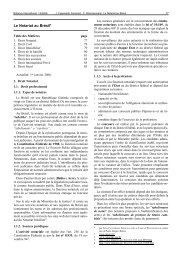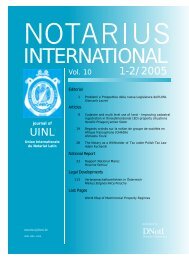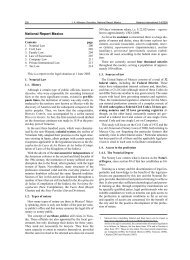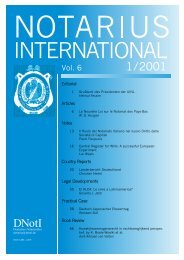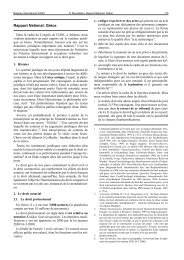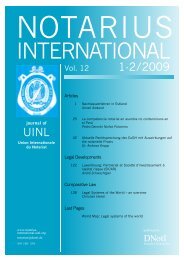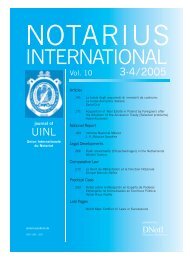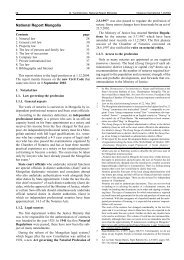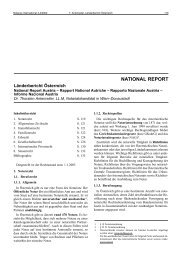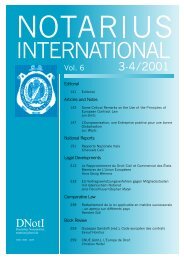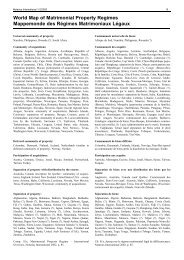ARTICLES and NOTES - Notarius International
ARTICLES and NOTES - Notarius International
ARTICLES and NOTES - Notarius International
Create successful ePaper yourself
Turn your PDF publications into a flip-book with our unique Google optimized e-Paper software.
<strong>Notarius</strong> <strong>International</strong> 3-4/2002 F. Tassinari, Reform of the limited liability company in Italy 197<br />
personal aspects <strong>and</strong>, above all, through its elimination of<br />
any circumstance when the member would be liable to<br />
the company’s creditors for the company’s debt 5 .<br />
The Germanic <strong>and</strong> French models were already beginning<br />
to spread through Europe <strong>and</strong> other continents before<br />
the outbreak of the Second World War. The countries<br />
affected included Belgium (1925), Switzerl<strong>and</strong> (1936),<br />
together with East European <strong>and</strong> African countries 6 .<br />
After the Second World War the model was taken up by<br />
Spain (1953) 7 by Greece (1955), Holl<strong>and</strong> (1971) <strong>and</strong><br />
Denmark (1973), in these two latter cases, as a consequence<br />
of their entry into the European Community.<br />
Keeping within European boundaries, the „S.r.l.“ model“<br />
remained largely unknown in Sc<strong>and</strong>inavian countries.<br />
The share based company model was particularly<br />
flexible in these countries (in Sweden aktiebolag) 8 , so a<br />
need for the introduction of this further company type has<br />
not been particularly felt until now.<br />
Finally, a model of the limited liability company has had<br />
unexpected success over the last 25 years in the legal systems<br />
of the United States where the European model represented<br />
the reference for the introduction of the „Limited<br />
Liability company“. It can be distinguished from corporations,<br />
in their forms both of publicly held corporation<br />
<strong>and</strong> of closely-held corporation, by the greater importance<br />
given to each individual member in the management of the<br />
business activity <strong>and</strong> by their simplified rules of formation<br />
<strong>and</strong> operation. In particular, the „limited liability company<br />
(llc) was first used in the State of Wyoming in 1977. It is<br />
now part of the law in all 50 U.S. states (apart from the<br />
District of Columbia). Some of these states (including Delaware<br />
<strong>and</strong> New York) include provisions validating the existence<br />
of sole member companies 9 .<br />
1.2. Choices made by the Italian Legislators of 1942<br />
The „S.r.l.“ model started life in Italy, as is well known,<br />
with the entry into force of the Italian Civil Code in<br />
1942. The 19th century Commercial Code had envisaged<br />
three forms of commercial company: the collective, the<br />
„accom<strong>and</strong>ita“ a kind of limited partnership <strong>and</strong> the<br />
company on shares.<br />
In the preparation of the Code account was taken on the<br />
one h<strong>and</strong>, of the positive experiences of foreign countries<br />
which had introduced the Germanic model with a more<br />
advanced capitalist system than that existing in Italy. On<br />
the other h<strong>and</strong> account was also taken of the difficulties<br />
which had been encountered in the attempts to widen the<br />
scope of application of the Italian anonymous company<br />
on the basis of the existing model, particularly after the<br />
unpopularity of the quota-based anonymous company instituted<br />
in the 1882 Commercial Code 10 .<br />
1.2.1. Bills Vivante <strong>and</strong> d'Amelio of 1922 <strong>and</strong> 1925<br />
The success enjoyed by the foreign models to which<br />
reference was made in the preceding section, had lead to<br />
the creation of a school of thought in favour of the introduction<br />
of a new capital based company in Italy as early<br />
as the period marking the immediate aftermath of the<br />
First World War. The idea was that such a form would be<br />
better adapted to the requirements of smaller businesses<br />
as distinct from the anonymous company, following the<br />
drawing up of an autonomous body of law permitting a<br />
clear differentiation to be made between the two types.<br />
This was the essential thrust of the 1922 Vivante Bill.<br />
The importance was noted (in the context of a new type of<br />
„company limited by guarantee“) of promoting „the association<br />
of a small number of members wishing to have a<br />
more or less wide-ranging involvement in the company’s<br />
management without exposing themselves to the risk of<br />
unlimited liability (as in the collective company) <strong>and</strong><br />
without putting themselves into the h<strong>and</strong>s of a manager<br />
who may then become the company’s effective owner (as<br />
in the „accom<strong>and</strong>ita“ type)“ through the new legislative<br />
scheme proposed, emphasising in this way the view of the<br />
new form as a type more related to the personal company<br />
rather than that based on share capital 11 . Then there was<br />
the D’Amelio Bill of 1925. This proposed something<br />
along similar lines, using the same name, although in fact<br />
it was very different from the share model (e.g. reservation<br />
of administration by one or more members, requirement<br />
of unanimity for amendment of the Articles).<br />
1.2.2. Bill Asquini of 1940<br />
With the failure of the various bills put forward during<br />
the 1920s, there was a significant change in perspective<br />
in the context of the preparatory work for the unitary Civil<br />
Code of 1942 with the Asquini Bill of 1940. The „Società<br />
a responsibilità limitata“ (limited liability company)<br />
– given this name in recognition of the most common<br />
name abroad – „was intended as a substitution for the<br />
company with shares where the latter appeared to be too<br />
complex a body for a company business of modest size.<br />
It is precisely because the body is small that greater<br />
weight is given to the member which he cannot have<br />
within the structure of the company with shares“ 12 .<br />
The view expressed by the majority of the literature on<br />
the subject 13 was in agreement that the Asquini Bill was<br />
a step backwards with respect to the earlier bills proposed<br />
5 For a comment on this historic model cf. J. Tabet, Les sociétés à resposabilité<br />
limitée en France, Paris, 1955; For an up-dated summary<br />
of the current S.r.l. in France however cf. B. Petit, Droit des sociétés,<br />
Litec, 2002, p. 135 et seq.<br />
6 For references, cf. G.C.M. Rivolta, op. cit., p. 14 et seq.<br />
7 In Spain the subject was regulated ex novo by the law 2/1995 de 23rd<br />
March of Sociedades de Responsabilidad Limitada (LSL), which can<br />
today be taken as one of the Community models most suitable for the<br />
assessment of the Italian reform (on this question, cf. F.C. Chulia, Introducciòn<br />
al derecho mercantil, Valencia, 1998, p. 437 et seq.).<br />
8 Cf. I. Zoogling, Schwedisches Gesellschaftsrecht, in Gesellschaftsrecht<br />
in Europa, edited by M. Eiselberg, Vienna, 997, p. 245 et seq.<br />
9 Cf., W. Burnham, Introduction to the law <strong>and</strong> legal system of the<br />
United States, West Group, 1999 (II ed.), above all at p. 532 et seq.<br />
(Business law), p. 550 et seq.<br />
10 See G.C.M. Rivolta, op. cit., p. 24<br />
11 Relazione al progetto, edited by A. Asquini, cit. in G.C.M. Rivolta,<br />
op. cit., p. 26.<br />
12 Relazione del Guardasigilli al Progetto ministeriale del codice di<br />
commercio, Rome, 1940, p. 97.<br />
13 F. Cavazzuti, Società a responsabilità limitata, in Noviss.dig.it., Turn,<br />
1971, p. 7; G. Santini, op.cit., p. 9 et seq.; A. Brunetti notes in particular,<br />
in Trattato di diritto delle società, Milan, 1948 - 1950, vol. III;<br />
p. 10 et seq., that the main reason for the move backwards was the<br />
decision not to set up the S.r.l. as an autonomous form, an intermediate<br />
type between the collective <strong>and</strong> anonymous company. This was<br />
on the basis of the (political) objective to give small businesses a<br />
structure similar to that of the share company with the new law.



